Seat Alhambra 2009 Owner's Manual
Manufacturer: SEAT, Model Year: 2009, Model line: Alhambra, Model: Seat Alhambra 2009Pages: 285, PDF Size: 7.62 MB
Page 231 of 285
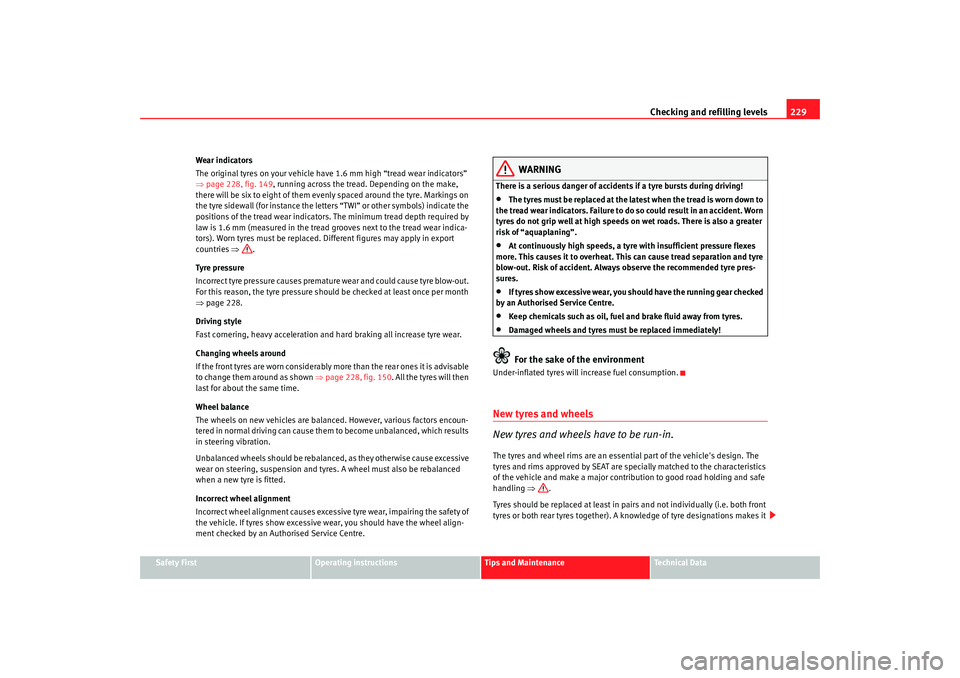
Checking and refilling levels229
Safety First
Operating instructions
Tips and Maintenance
Te c h n i c a l D a t a
Wear indicators
The original tyres on your vehicle have 1.6 mm high “tread wear indicators”
⇒
page 228, fig. 149 , running across the tread. Depending on the make,
there will be six to eight of them evenly spaced around the tyre. Markings on
the tyre sidewall (for instance the letters “TWI” or other symbols) indicate the
positions of the tread wear indicators. The minimum tread depth required by
law is 1.6 mm (measured in the tread grooves next to the tread wear indica-
tors). Worn tyres must be replaced. Different figures may apply in export
countries ⇒.
Tyre pressure
Incorrect tyre pressure causes premature wear and could cause tyre blow-out.
For this reason, the tyre pressure should be checked at least once per month
⇒ page 228.
Driving style
Fast cornering, heavy acceleration and hard braking all increase tyre wear.
Changing wheels around
If the front tyres are worn considerably more than the rear ones it is advisable
to change them around as shown ⇒page 228, fig. 150 . All the tyres will then
last for about the same time.
Wheel balance
The wheels on new vehicles are balanced. However, various factors encoun-
tered in normal driving can cause them to become unbalanced, which results
in steering vibration.
Unbalanced wheels should be rebalanced, as they otherwise cause excessive
wear on steering, suspension and tyres. A wheel must also be rebalanced
when a new tyre is fitted.
Incorrect wheel alignment
Incorrect wheel alignment causes excessive tyre wear, impairing the safety of
the vehicle. If tyres show excessive wear, you should have the wheel align-
ment checked by an Authorised Service Centre.
WARNING
There is a serious danger of accidents if a tyre bursts during driving!•
The tyres must be replaced at the latest when the tread is worn down to
the tread wear indicators. Failure to do so could result in an accident. Worn
tyres do not grip well at high speeds on wet roads. There is also a greater
risk of “aquaplaning”.
•
At continuously high speeds, a tyre with insufficient pressure flexes
more. This causes it to overheat. This can cause tread separation and tyre
blow-out. Risk of accident. Always observe the recommended tyre pres-
sures.
•
If tyres show excessive wear, you should have the running gear checked
by an Authorised Service Centre.
•
Keep chemicals such as oil, fuel and brake fluid away from tyres.
•
Damaged wheels and tyres must be replaced immediately!For the sake of the environment
Under-inflated tyres will increase fuel consumption.New tyres and wheels
New tyres and wheels have to be run-in.The tyres and wheel rims are an essential part of the vehicle's design. The
tyres and rims approved by SEAT are specially matched to the characteristics
of the vehicle and make a major contribution to good road holding and safe
handling ⇒.
Tyres should be replaced at least in pairs and not individually (i.e. both front
tyres or both rear tyres together). A knowledge of tyre designations makes it
alhambra_aleman.book Seite 229 Montag, 23. M‰ rz 2009 1:12 13
Page 232 of 285
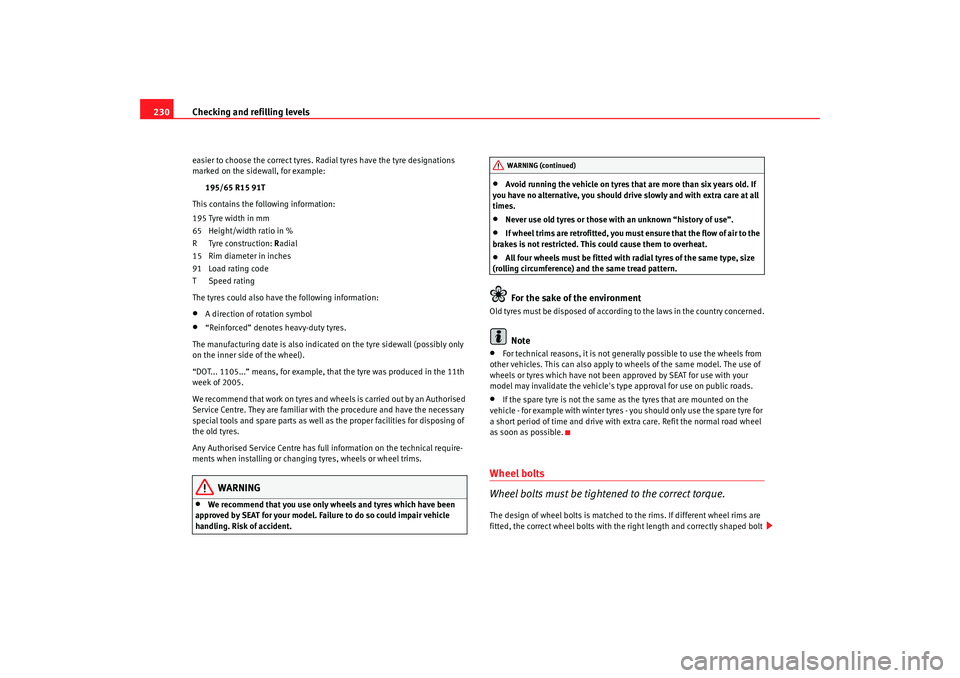
Checking and refilling levels
230easier to choose the correct tyres. Radial tyres have the tyre designations
marked on the sidewall, for example:
195/65 R15 91T
This contains the following information:
195 Tyre width in mm
65 Height/width ratio in %
R Tyre construction: Radial
15 Rim diameter in inches
91 Load rating code
T Speed rating
The tyres could also have the following information:•
A direction of rotation symbol
•
“Reinforced” denotes heavy-duty tyres.
The manufacturing date is also indicated on the tyre sidewall (possibly only
on the inner side of the wheel).
“DOT... 1105...” means, for example, that the tyre was produced in the 11th
week of 2005.
We recommend that work on tyres and wheels is carried out by an Authorised
Service Centre. They are familiar with the procedure and have the necessary
special tools and spare parts as well as the proper facilities for disposing of
the old tyres.
Any Authorised Service Centre has full information on the technical require-
ments when installing or changing tyres, wheels or wheel trims.
WARNING
•
We recommend that you use only wheels and tyres which have been
approved by SEAT for your model. Failure to do so could impair vehicle
handling. Risk of accident.
•
Avoid running the vehicle on tyres that are more than six years old. If
you have no alternative, you should drive slowly and with extra care at all
times.
•
Never use old tyres or those with an unknown “history of use”.
•
If wheel trims are retrofitted, you must ensure that the flow of air to the
brakes is not restricted. This could cause them to overheat.
•
All four wheels must be fitted with radial tyres of the same type, size
(rolling circumference) and the same tread pattern.For the sake of the environment
Old tyres must be disposed of according to the laws in the country concerned.
Note
•
For technical reasons, it is not generally possible to use the wheels from
other vehicles. This can also apply to wheels of the same model. The use of
wheels or tyres which have not been approved by SEAT for use with your
model may invalidate the vehicle's type approval for use on public roads.
•
If the spare tyre is not the same as the tyres that are mounted on the
vehicle - for example with winter tyres - you should only use the spare tyre for
a short period of time and drive with extra care. Refit the normal road wheel
as soon as possible.
Wheel bolts
Wheel bolts must be tightened to the correct torque.The design of wheel bolts is matched to the rims. If different wheel rims are
fitted, the correct wheel bolts with the right length and correctly shaped bolt
WARNING (continued)
alhambra_aleman.book Seite 230 Montag, 23. M‰ rz 2009 1:12 13
Page 233 of 285
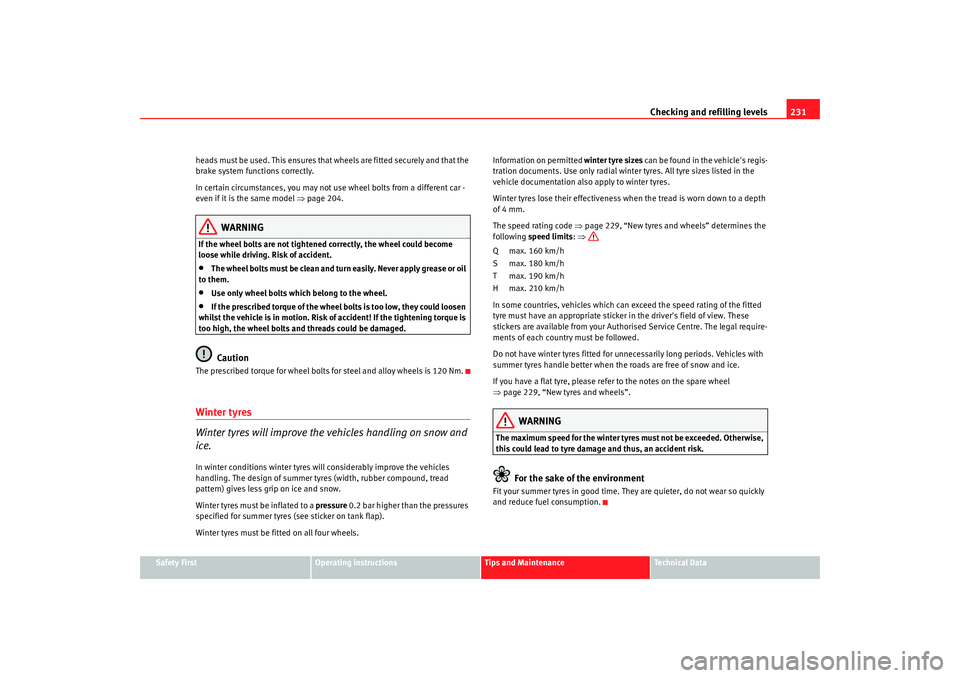
Checking and refilling levels231
Safety First
Operating instructions
Tips and Maintenance
Te c h n i c a l D a t a
heads must be used. This ensures that wheels are fitted securely and that the
brake system functions correctly.
In certain circumstances, you may not use wheel bolts from a different car -
even if it is the same model
⇒page 204.
WARNING
If the wheel bolts are not tightened correctly, the wheel could become
loose while driving. Risk of accident.•
The wheel bolts must be clean and turn easily. Never apply grease or oil
to them.
•
Use only wheel bolts which belong to the wheel.
•
If the prescribed torque of the wheel bolts is too low, they could loosen
whilst the vehicle is in motion. Risk of accident! If the tightening torque is
too high, the wheel bolts and threads could be damaged.Caution
The prescribed torque for wheel bolts for steel and alloy wheels is 120 Nm.Winter tyres
Winter tyres will improve the vehicles handling on snow and
ice.In winter conditions winter tyres will considerably improve the vehicles
handling. The design of summer tyres (width, rubber compound, tread
pattern) gives less grip on ice and snow.
Winter tyres must be inflated to a pressure 0.2 bar higher than the pressures
specified for summer tyres (see sticker on tank flap).
Winter tyres must be fitted on all four wheels. Information on permitted
winter tyre sizes can be found in the vehicle's regis-
tration documents. Use only radial winter tyres. All tyre sizes listed in the
vehicle documentation also apply to winter tyres.
Winter tyres lose their effectiveness when the tread is worn down to a depth
of 4 mm.
The speed rating code ⇒page 229, “New tyres and wheels” determines the
following speed limits : ⇒
Q max. 160 km/h
S max. 180 km/h
T max. 190 km/h
H max. 210 km/h
In some countries, vehicles which can exceed the speed rating of the fitted
tyre must have an appropriate sticker in the driver's field of view. These
stickers are available from your Authorised Service Centre. The legal require-
ments of each country must be followed.
Do not have winter tyres fitted for unnecessarily long periods. Vehicles with
summer tyres handle better when the roads are free of snow and ice.
If you have a flat tyre, please refer to the notes on the spare wheel
⇒ page 229, “New tyres and wheels”.
WARNING
The maximum speed for the winter tyres must not be exceeded. Otherwise,
this could lead to tyre damage and thus, an accident risk.
For the sake of the environment
Fit your summer tyres in good time. They are quieter, do not wear so quickly
and reduce fuel consumption.
alhambra_aleman.book Seite 231 Montag, 23. M‰ rz 2009 1:12 13
Page 234 of 285
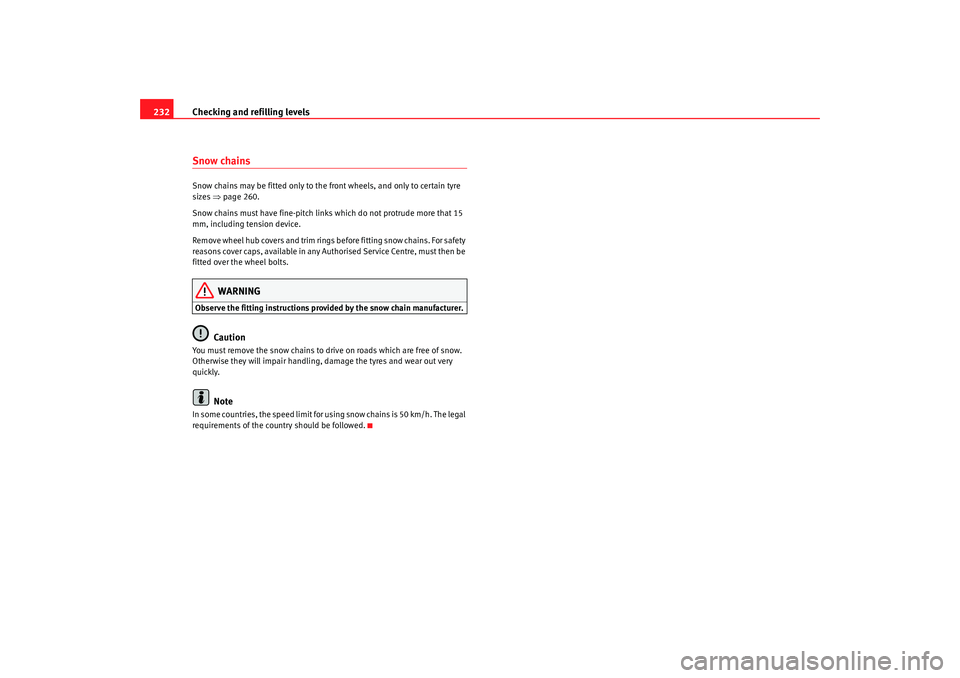
Checking and refilling levels
232Snow chainsSnow chains may be fitted only to the front wheels, and only to certain tyre
sizes ⇒page 260.
Snow chains must have fine-pitch links which do not protrude more that 15
mm, including tension device.
Remove wheel hub covers and trim rings before fitting snow chains. For safety
reasons cover caps, available in any Authorised Service Centre, must then be
fitted over the wheel bolts.
WARNING
Observe the fitting instructions provided by the snow chain manufacturer.
Caution
You must remove the snow chains to drive on roads which are free of snow.
Otherwise they will impair handling, damage the tyres and wear out very
quickly.
Note
In some countries, the speed limit for using snow chains is 50 km/h. The legal
requirements of the country should be followed.
alhambra_aleman.book Seite 232 Montag, 23. M‰ rz 2009 1:12 13
Page 235 of 285
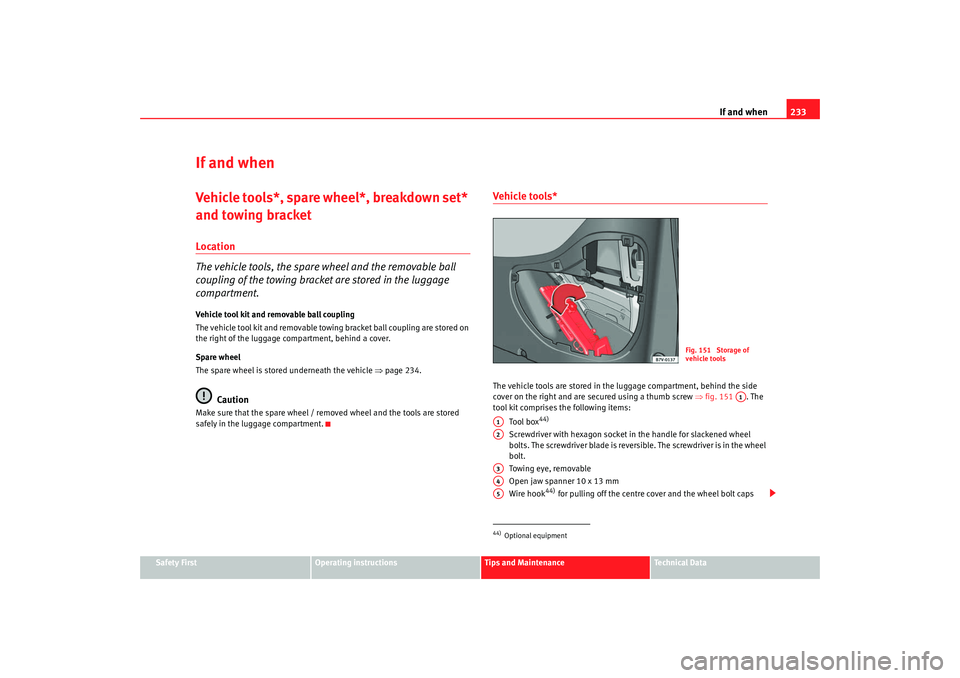
If and when233
Safety First
Operating instructions
Tips and Maintenance
Te c h n i c a l D a t a
If and whenVehicle tools*, spare wheel*, breakdown set*
and towing bracketLocation
The vehicle tools, the spare wheel and the removable ball
coupling of the towing bracket are stored in the luggage
compartment.Vehicle tool kit and removable ball coupling
The vehicle tool kit and removable towing bracket ball coupling are stored on
the right of the luggage compartment, behind a cover.
Spare wheel
The spare wheel is stored underneath the vehicle ⇒page 234.
Caution
Make sure that the spare wheel / removed wheel and the tools are stored
safely in the luggage compartment.
Vehicle tools*The vehicle tools are stored in the luggage compartment, behind the side
cover on the right and are secured using a thumb screw ⇒fig. 151 . The
tool kit comprises the following items:
To ol b ox
44)
Screwdriver with hexagon socket in the handle for slackened wheel
bolts. The screwdriver blade is reversible. The screwdriver is in the wheel
bolt.
Towing eye, removable
Open jaw spanner 10 x 13 mm
Wire hook
44) for pulling off the centre cover and the wheel bolt caps
44)Optional equipment
Fig. 151 Storage of
vehicle tools
A1
A1A2A3A4A5
alhambra_aleman.book Seite 233 Montag, 23. M‰ rz 2009 1:12 13
Page 236 of 285
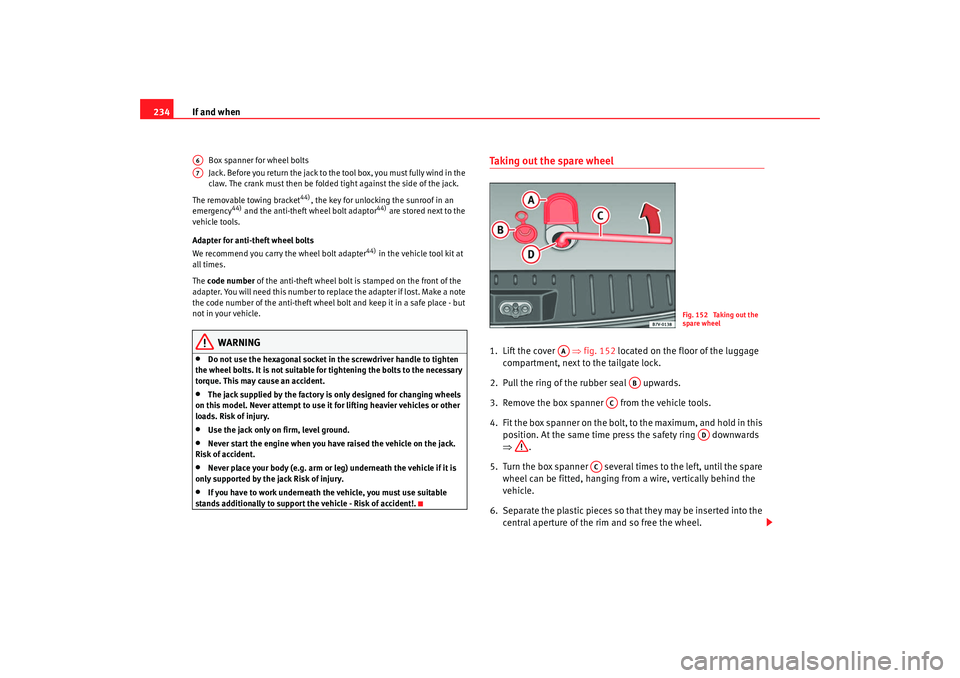
If and when
234
Box spanner for wheel bolts
Jack. Before you return the jack to the tool box, you must fully wind in the
claw. The crank must then be folded tight against the side of the jack.
The removable towing bracket
44), the key for unlocking the sunroof in an
emergency
44) and the anti-theft wheel bolt adaptor
44) are stored next to the
vehicle tools.
Adapter for anti-theft wheel bolts
We recommend you carry the wheel bolt adapter
44) in the vehicle tool kit at
all times.
The code number of the anti-theft wheel bolt is stamped on the front of the
adapter. You will need this number to replace the adapter if lost. Make a note
the code number of the anti-theft wheel bolt and keep it in a safe place - but
not in your vehicle.
WARNING
•
Do not use the hexagonal socket in the screwdriver handle to tighten
the wheel bolts. It is not suitable for tightening the bolts to the necessary
torque. This may cause an accident.
•
The jack supplied by the factory is only designed for changing wheels
on this model. Never attempt to use it for lifting heavier vehicles or other
loads. Risk of injury.
•
Use the jack only on firm, level ground.
•
Never start the engine when you have raised the vehicle on the jack.
Risk of accident.
•
Never place your body (e.g. arm or leg) underneath the vehicle if it is
only supported by the jack Risk of injury.
•
If you have to work underneath the vehicle, you must use suitable
stands additionally to support the vehicle - Risk of accident!.
Taking out the spare wheel1. Lift the cover ⇒fig. 152 located on the floor of the luggage
compartment, next to the tailgate lock.
2. Pull the ring of the rubber seal upwards.
3. Remove the box spanner from the vehicle tools.
4. Fit the box spanner on the bolt, to the maximum, and hold in this position. At the same time press the safety ring downwards
⇒ .
5. Turn the box spanner several times to the left, until the spare wheel can be fitted, hanging from a wire, vertically behind the
vehicle.
6. Separate the plastic pieces so that they may be inserted into the central aperture of the rim and so free the wheel.
A6A7
Fig. 152 Taking out the
spare wheel
AA
AB
AC
AD
AC
alhambra_aleman.book Seite 234 Montag, 23. M‰ rz 2009 1:12 13
Page 237 of 285
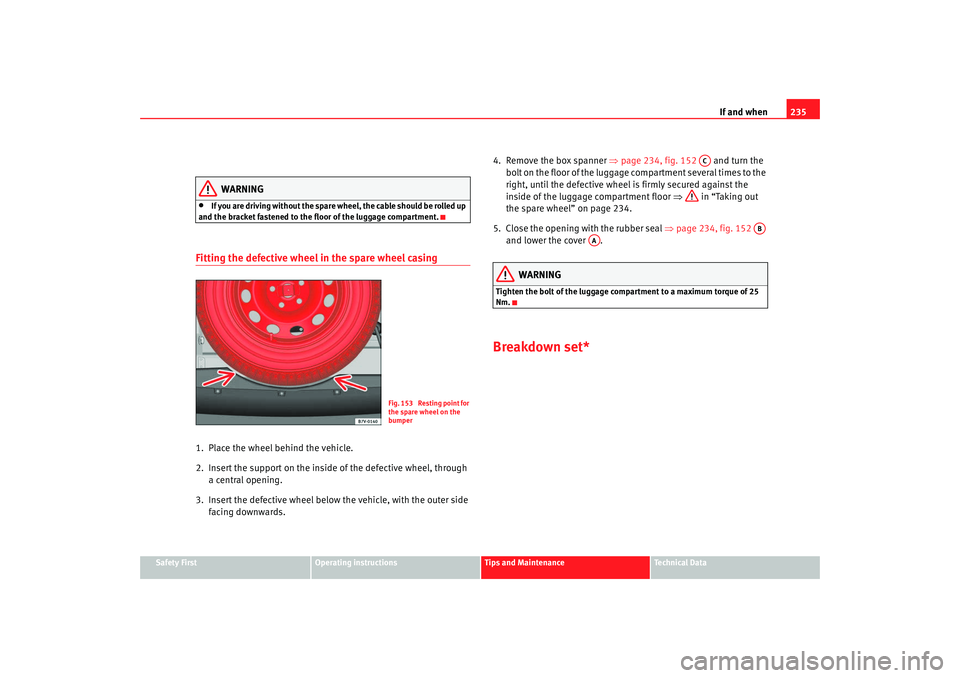
If and when235
Safety First
Operating instructions
Tips and Maintenance
Te c h n i c a l D a t a
WARNING
•
If you are driving without the spare wheel, the cable should be rolled up
and the bracket fastened to the floor of the luggage compartment.
Fitting the defective wheel in the spare wheel casing1. Place the wheel behind the vehicle.
2. Insert the support on the inside of the defective wheel, through a central opening.
3. Insert the defective wheel below the vehicle, with the outer side facing downwards. 4. Remove the box spanner
⇒page 234, fig. 152 and turn the
bolt on the floor of the luggage compartment several times to the
right, until the defective wheel is firmly secured against the
inside of the luggage compartment floor ⇒ in “Taking out
the spare wheel” on page 234.
5. Close the opening with the rubber seal ⇒page 234, fig. 152
and lower the cover .
WARNING
Tighten the bolt of the luggage compartment to a maximum torque of 25
Nm.Breakdown set*
Fig. 153 Resting point for
the spare wheel on the
bumper
AC
AB
AA
alhambra_aleman.book Seite 235 Montag, 23. M‰ rz 2009 1:12 13
Page 238 of 285
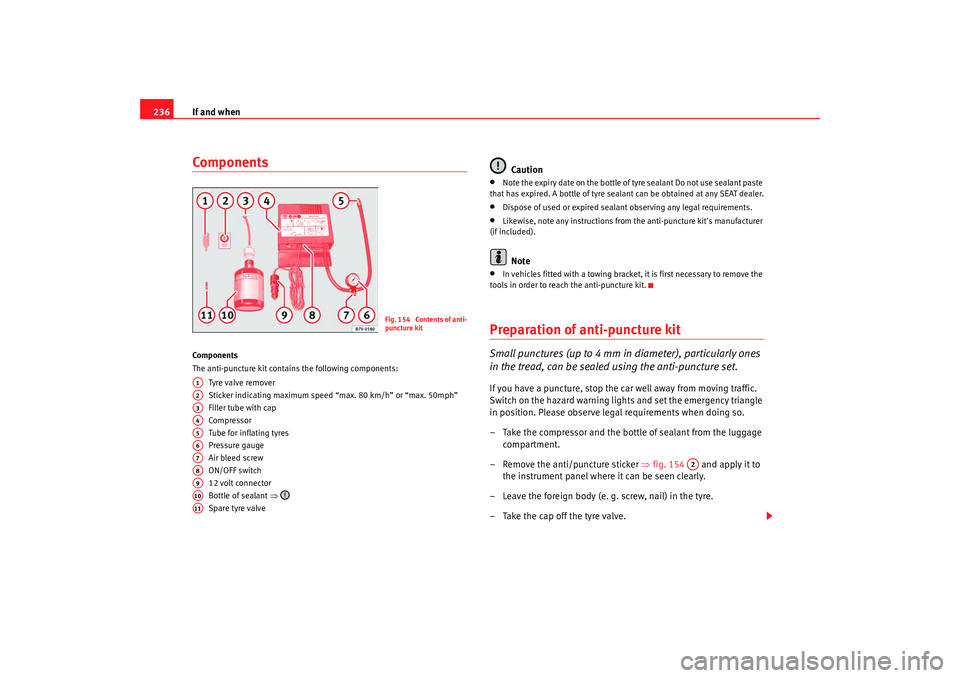
If and when
236ComponentsCo mp on e nts
The anti-puncture kit contains the following components:
Tyre valve remover
Sticker indicating maximum speed “max. 80 km/h” or “max. 50mph”
Filler tube with cap
Compressor
Tube for inflating tyres
Pressure gauge
Air bleed screw
ON/OFF switch
12 volt connector
Bottle of sealant ⇒
Spare tyre valve
Caution
•
Note the expiry date on the bottle of tyre sealant Do not use sealant paste
that has expired. A bottle of tyre sealant can be obtained at any SEAT dealer.
•
Dispose of used or expired sealant observing any legal requirements.
•
Likewise, note any instructions from the anti-puncture kit's manufacturer
(if included).Note
•
In vehicles fitted with a towing bracket, it is first necessary to remove the
tools in order to reach the anti-puncture kit.
Preparation of anti-puncture kitSmall punctures (up to 4 mm in diameter), particularly ones
in the tread, can be sealed using the anti-puncture set.If you have a puncture, stop the car well away from moving traffic.
Switch on the hazard warning lights and set the emergency triangle
in position. Please observe legal requirements when doing so.
– Take the compressor and the bottle of sealant from the luggage compartment.
– Remove the anti/puncture sticker ⇒fig. 154 and apply it to
the instrument panel where it can be seen clearly.
– Leave the foreign body (e. g. screw, nail) in the tyre.
– Take the cap off the tyre valve.
Fig. 1 54 Conte nts of ant i-
puncture kit
A1A2A3A4A5A6A7A8A9A10A11
A2
alhambra_aleman.book Seite 236 Montag, 23. M‰ rz 2009 1:12 13
Page 239 of 285
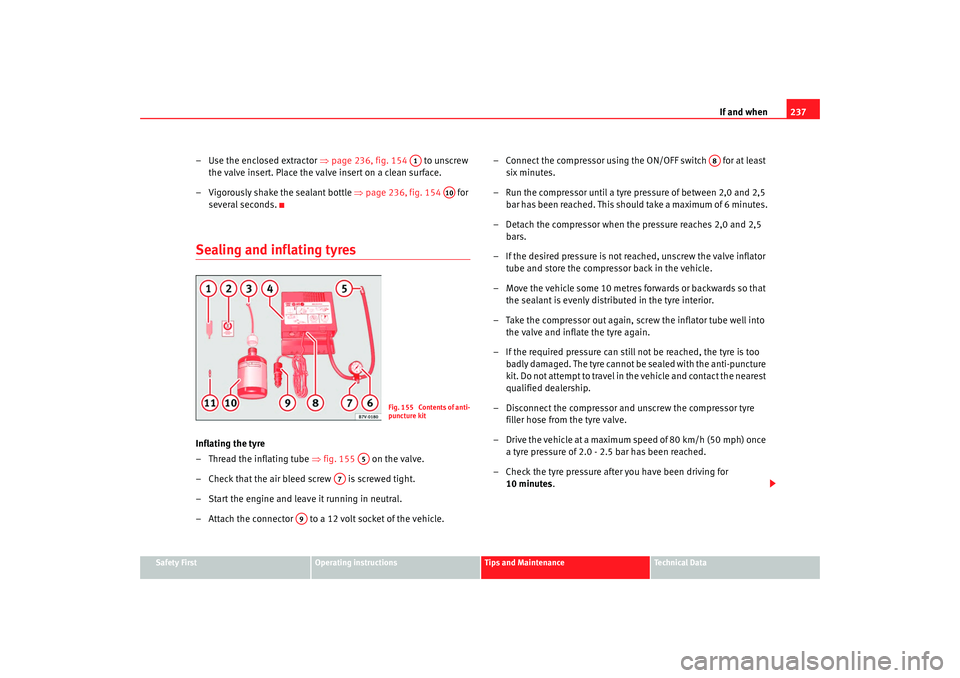
If and when237
Safety First
Operating instructions
Tips and Maintenance
Te c h n i c a l D a t a
– Use the enclosed extractor ⇒page 236, fig. 154 to unscrew
the valve insert. Place the valve insert on a clean surface.
– Vigorously shake the sealant bottle ⇒page 236, fig. 154 for
several seconds.Sealing and inflating tyresInflating the tyre
– Thread the inflating tube ⇒fig. 155 on the valve.
– Check that the air bleed screw is screwed tight.
– Start the engine and leave it running in neutral.
– Attach the connector to a 12 volt socket of the vehicle. – Connect the compressor using the ON/OFF switch for at least
six minutes.
– Run the compressor until a tyre pressure of between 2,0 and 2,5 b ar has b ee n rea che d. This sh ould ta ke a ma xi m um of 6 mi n utes.
– Detach the compressor when the pressure reaches 2,0 and 2,5 bars.
– If the desired pressure is not reached, unscrew the valve inflator tube and store the compressor back in the vehicle.
– Move the vehicle some 10 metres forwards or backwards so that the sealant is evenly distributed in the tyre interior.
– Take the compressor out again, screw the inflator tube well into the valve and inflate the tyre again.
– If the required pressure can still not be reached, the tyre is too badly damaged. The tyre cannot be sealed with the anti-puncture
kit. Do not attempt to travel in the vehicle and contact the nearest
qualified dealership.
– Disconnect the compressor and unscrew the compressor tyre filler hose from the tyre valve.
– Drive the vehicle at a maximum speed of 80 km/h (50 mph) once a tyre pressure of 2.0 - 2.5 bar has been reached.
– Check the tyre pressure after you have been driving for 10 minutes .
A1
A10
Fig. 1 55 Conte nts of ant i-
puncture kit
A5
A7
A9
A8
alhambra_aleman.book Seite 237 Montag, 23. M‰ rz 2009 1:12 13
Page 240 of 285

If and when
238
WARNING
•
Do not allow the sealant to get onto your skin or into your eyes. Risk of
injury.
•
Keep children away from the sealant.
Changing a wheel Preparation
You must park the vehicle correctly before changing a tyre.– If you have a flat tyre or puncture, park the car as far away from the flow of traffic as possible on a flat surface.
– Switch off the engine. Switch on the hazard warning lights.
– Apply the handbrake firmly and engage a gear or put the selector in the P position.
– Chock the wheel opposite the wheel being changed with a stone or similar object.
– If you are towing a trailer, unhitch it from your vehicle.
– Remove the spare wheel and the vehicle tools from the luggage compartment.
– All passengers should leave the car. They should wait in a safe place (for instance behind the safety barrier).
WARNING
•
If you have a puncture, stop the car well away from moving traffic.
Switch on the hazard warning lights and set the emergency triangle in
position. Please observe legal requirements when doing so.
•
All passengers should leave the car.
•
Apply the handbrake firmly and engage a gear or put the gear selector
in the P position. Chock the wheel opposite the wheel being changed with
a stone or similar object.
•
If you are towing a trailer, unhitch it from your vehicle.
•
Only use jacks which have been approved for your vehicle by SEAT.
•
Never use other jacks, even if they have been approved for use on other
SEAT models. The jack could slip. Risk of injury.
•
Never start the engine when the vehicle is raised. This may cause an
accident.
•
Never place your body (e.g. arm or leg) underneath the vehicle if it is
only supported by the jack Risk of injury.
•
If you have to work underneath the vehicle, you must use suitable
stands additionally to support the vehicle - Risk of accident!.
alhambra_aleman.book Seite 238 Montag, 23. M‰ rz 2009 1:12 13